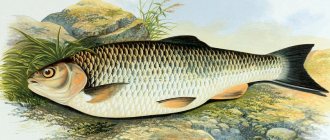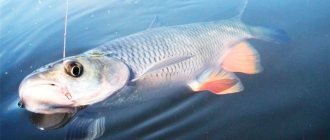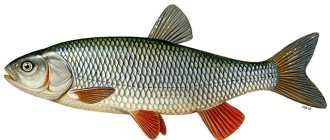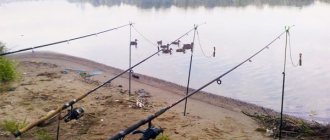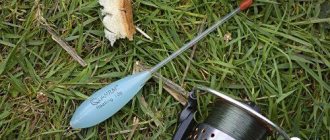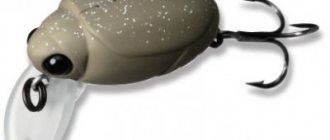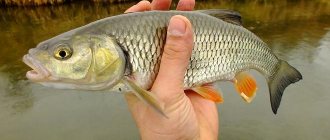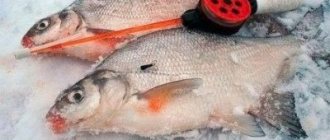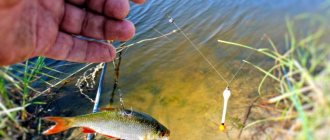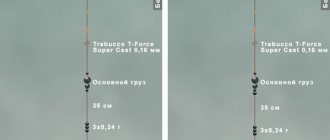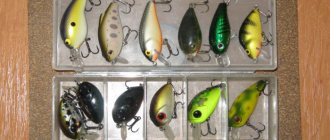The chub is quite widespread. This is an interesting fish for fishing, lively, lively and active. An excellent choice for hunting for bigheaded fish would be to catch chub with a fishing rod.
The main thing is to choose the right fish for specific conditions, select bait, find fish in the pond and know how best to present it with bait.
The behavior of fish varies greatly depending on the season. For example, catching chub in July with a float rod is very different from spring or autumn fishing.
If you take into account all the important nuances, the fish will bite well, the fishing will be interesting, and the catch will be worthy.
About the chub
Content
The chub or, scientifically, Squalius cephalus is a large fish of the carp family. In the literature there are references to giants weighing up to two pounds, but the existence of such chubs was already in doubt during the time of Sabaneev. Today, a chub weighing more than two kilograms can well be considered a trophy, and its maximum weight reaches 5–6 kg. This strong and beautiful fish is most common in small and medium-sized rivers and is practically never found in reservoirs with stagnant water.
Chub is a large fish of the carp family.
Catching chub in the spring with a fishing rod
Where to look for chub in spring
The activity of fish, and, therefore, catching chub in the spring with a fishing rod depends on the time of year. In spring and summer, fish are most active. Mostly during this period, chub can be found in snags, near bridges, the piles of which go under water.
Also, this species prefers to be on the border of strong and weak currents. Since the chub is partial to various insects, we can say that this is its main food; it can also be found in areas of reservoirs adjacent to the forest thicket, where tree branches descend directly into the water. The chub does not go overboard with its food. Its diet can include both animal and plant foods. He eats frogs, shellfish, and even berries. Large fish happily eat minnows and bleaks.
The chub prefers to feed in the spring when it is light. However, at this time you can only catch small specimens, which during the day collect insects falling into the pond. But large individuals are inactive at this time. They come out late in the evening in search of food.
When the insects disappear, the chub leaves the coastal area, but continues to be active at the depths of the reservoir.
Where to look for chub
In small and medium-sized rivers, the favorite habitats of the chub are:
- riffles;
- holes near steep banks;
- tree crowns hanging over the water;
- large snags and boulders.
In large rivers and reservoirs, chub stay near holes leading to shallows and near large submerged objects. The chub also gravitates towards artificial structures - bridge piles, dams, piers.
There is no point in looking for chub in places with a muddy bottom, as well as in creeks and bays overgrown with algae.
Contrary to the fisherman's expectations, the chub often stands in the current not behind an obstacle, but right in front of it, collecting food that the water brings.
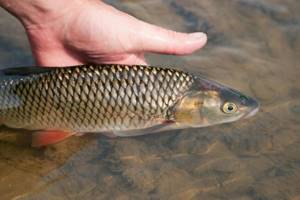
In large rivers and reservoirs, the chub stays near the pits
Features of behavior
This handsome silver fish with a slab-like strong body prefers to stay with the current, so it is a typical river inhabitant; sometimes it enters flowing lakes, but this is very rare.
But river riffles and turns with fast currents are his element. Moreover, it is found in large and small rivers, as well as in very small streams.
In reservoirs, chub prefers to stay close to inflowing rivers and streams.
In rivers, the chub likes to stay near the banks with overhanging bushes or trees, under which it collects fallen insects, for example, dragonflies or the same cherry berries. Also, the favorite habitats of the silver beauty are rapids and rifts, steep banks. He does not like to stand on the muddy bottom, in places with dying algae.
The large mouth of this fish indicates its predatory preferences, although in fact the chub can be called a semi-predatory fish, because in addition to small fish, its diet includes insects: dragonflies, grasshoppers, as well as worms, crayfish and plant foods. Many people have probably heard that in the summer, catching chub with a grasshopper, cherry or corn can be very successful.
In addition, starting from June, the chub feeds on mud and algae that grow on underwater snags, and strong pharyngeal teeth allow it to grind the shells of crayfish or snail shells. Therefore, catching chub with crayfish also often brings success.
Closer to autumn, the chub switches to increased nutrition; the main dish in its diet is the fry of narrow-bodied fish: verkhovka or gudgeon. And with the onset of the winter season, it slides into holes and hardly feeds, becoming more active only on the last ice. However, there are rivers in which you can successfully catch chub even in winter while ice fishing.
Chub spawning coincides with the flowering of bird cherry, and it begins in April or May, depending on the region of the country. The peculiarity of the chub spawn is that, unlike most fish, it does not stop feeding.
Therefore, chub spawning is not an obstacle to its biting. But all the same, the chub’s zhor comes, like other fish species, a week after spawning, in May-June.
It is necessary to say about one more feature of chub fishing.
This fish is very careful; it can notice a person on the shore from a great distance and hide in a secluded place in its river, so you need to carefully camouflage yourself.
For example, in sunny weather you should not approach the place where you will catch chub so that a shadow falls on the water.
The chub is a fairly large, strong and beautiful inhabitant of the freshwater rivers of Europe. The most prominent individuals of this species reach a length of about 80 cm and weigh more than 8 kg. The fish is a semi-predatory fish; its diet includes bottom mollusks, insects, larvae, caterpillars and midges found in the upper layers of water, as well as algae growing on snags and mud.
What do you use to catch chub?
Considering the omnivorous nature of the chub, you can catch it with almost any equipment: a float rod, spinning rod, bottom tackle and fly fishing. At the same time, the choice of baits and artificial baits is simply huge.
Read more
Catching crucian carp with a float rod
Nozzles can be:
- bread;
- corn;
- peas;
- steamed grains of wheat or pearl barley;
- cheese;
- chicken liver and other entrails;
- pieces of lard, meat, sausage or frankfurters;
- whole cherries and mulberries.
The following are used as bait:
- worm - earthworm or crawling;
- live bait - preferably with a narrow body (bleak, minnow or minnow);
- frog;
- leech;
- various insects during their emergence (especially the May beetle and grasshoppers).
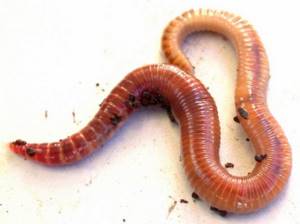
Many traditional baits for catching chub are no longer used due to their low availability:
- crayfish meat;
- blood clots;
- lamprey larva.
Fishing with a water ball
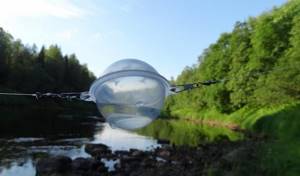
All the main elements of gear for catching chub using a tackle with a water ball are the same as in the case of float fishing. The difference lies directly in the equipment itself. Instead of a float, a water ball (water-filling float) is tied to the fishing line. A water balloon is a special transparent float with two valves. Using the first valve, you can draw water inside the ball, and using the second valve, the angler can drain this water. It is through these valves that the weight of the water ball is regulated.
It is especially worth noting that the water balloon is made of transparent material. Most often this material is plastic. Sometimes there are also water balloons made of glass. The leash can go either before or after the water ball. In any case, the water ball is always on the surface of the water. The bait will also be located here.
Recommended reading: Red sea bass
In the case of a water ball, it is better to use thin wire hooks. After all, such hooks will not drag the bait into the depths. When fishing with a water ball, it is wise to use insects as bait, which are the natural food of the chub at a particular time. The cockchafer, grasshopper, locust, dragonfly and other insects perform best in this role. Before fishing, fishing enthusiasts pay attention to the shores of the reservoir and the insects that are found here. These same insects probably constantly fall into the water and become prey for the chub. So try catching a couple of insects and fishing with them.
A regular float rig can also be used to create something similar to a water balloon rig. In this case, the weights are simply removed from the equipment. The float takes a lying position. Now put the same insect on the hook and move the bait as if fishing with a water ball. Do not place a float with bright colors, as such colors will likely scare away shy fish. But a black or green float will not arouse suspicion among the chub. You can even remove the float and replace it with a simple twig. A small branch will look natural on the water surface and the chub will not suspect a trick.
The disadvantage of using a conventional float as a water balloon is that it is impossible to regulate its weight. The float is light, and therefore it is simply impossible to make a long cast. So there are no full-fledged analogues to the water balloon. By the way, a bread crust would be an excellent bait for catching chub on a water ball. When fishing like this, you also catch crucian carp, carp, roach and bream.
When and where to catch chub with a regular fishing rod
Fishing for chub with a float rod can be carried out throughout the open water season. In early spring, immediately after the ice melts and before the water becomes cloudy, the chub emerges from its wintering pits and begins to feed in preparation for spawning. At this time, he is caught in the wiring in the lower layers of water.
As the water bodies warm up, the chub gradually moves to shallows and riffles, while its taste preferences change. The warmer the water, the more the chub is attracted to plant baits.
In the summer, after insects begin to emerge, the best bait for catching chub on a float are beetles, grasshoppers, and dragonflies. It is better to fish with them in the upper layers of water or on its surface. At this time, camouflage is especially important - if a chub notices an angler, you don’t have to wait for a bite.
In the fall, the colder the water, the easier it is to catch a chub using live bait or bait of animal origin. In late autumn, the activity of chub decreases, but its fishing can continue until freeze-up. Moreover, the closer winter gets, the less often the chub appears in shallow water.
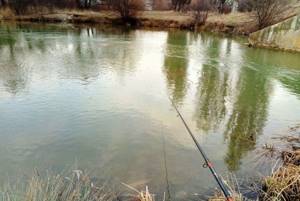
Catching chub with a float rod
The chub feeds both day and night. However, in summer the best bite occurs in the morning and evening dawns, and in spring and autumn - after 10–11 o’clock, when the water warms up a little. The largest specimens usually bite at night.
Equipment options
Basic
Standard equipment for catching chub with a fishing rod consists of a float, several pellet weights and a leash with a hook. It is well suited for fishing in a wide variety of conditions. You can improve it a little:
- put a sliding sinker on the main line;
- mount the stopper below;
- then attach a small pellet in front of the leash with the hook.
This rig is suitable for fishing in situations where the chub is reluctant to bite. The fish will feel less weight of the equipment when attacking the bait and take the hook more confidently.
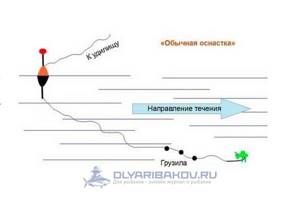
Long casting equipment
Equipment for long casting differs from the usual one in that it is better not to distribute the pellets along the fishing line, but to secure them all at one point, close to each other. In this case, you can also attach a small feeder in front of the leash. Another option is to use one olive instead of several grains.

Sliding float equipment
Used for catching chub with a float rod in situations where the depth at the fishing site exceeds the length of the rod. The installation looks like this:
- a stopper is mounted on the main line;
- then the sliding float is put on;
- then comes a damper (rubber, silicone, bead-shaped);
- after it, the sinkers, leash and hook are mounted.

Equipment without float
Often the best equipment for catching chub with a fishing rod is one without a float. In this case, sinkers are also not used; only a leash with a hook needs to be tied to the main fishing line. This setup is used for catching chub from the surface with fairly heavy baits - one or two May beetles, a grasshopper, or a bread crust can be attached to the hook.
Float tackle for chub
Rod and reel
To catch chub on a float, you can use both fly rods and fishing rods with running equipment. The choice is determined by the fishing conditions, but a fishing rod equipped with a reel has more options. It is better to use a carbon fiber rod, because it is held in your hands, and you have to cast the rod quite often. The most versatile rod length is 5–6 meters.
Read more
Catching perch with a float rod
The reels used are inertialess. You need to choose models with even laying of the fishing line and the ability to finely adjust the friction brake. Today, almost any reel, except the cheapest, can cope with this task.
Catching chub with a fly rod is effective only in those places where the fish comes close to the shore:
- between the trees and bushes growing on the shore;
- on steep banks;
- near bridges, piers and other structures.

You need a rod length of 5–6 meters to catch chub
Lines and leashes
To equip a float fishing rod, it is recommended to use a main line with a diameter of 0.16–0.18 mm and leashes of 0.12–0.16 mm. The use of fluorocarbon leaders is desirable, but not required. In combination with modern rods and reels, these diameters are enough to cope with chub of any size. Recommendations for the use of lines 0.25 mm and larger are replicated on the Internet, but are outdated. Their source is fishing literature from the times when the only fishing lines available were Klin and Chernigov.
Sinkers and hooks
The load should be sufficient to deliver the hook with the nozzle to the required depth, but not excessive. Too heavy a load roughens the tackle and reduces its sensitivity. The carrying capacity of the float must correspond to the weight of the sinker. To catch chub with a float rod, floats with a dough of 1.5–3.5 g are usually used.
It is better to choose hooks from carp series from well-known manufacturers. The size of the hook must match the size of the bait. The length of the leash is from 15 cm to half a meter.
Gear and equipment elements
Choosing a fishing rod
For catching chub on a simple fishing rod with a blind rig, rods of medium length are best suited - about 4-6 m. With shorter ones, in most situations it will not be possible to get the rig to promising points. With a fishing rod longer than 6 m, it becomes difficult to catch a chub. This fish offers quite decent resistance, so you need tackle that will allow you to confidently control a hooked trophy.
Bolognese and match fishing rods are good for catching chub . The first is designed primarily for fishing with long lines, when the equipment is released over several tens of meters. The second is designed for long-cast fishing.
Another advantage of Bolognese and match float fishing rods is that a reel with a friction brake greatly simplifies fishing for chubs. When fishing with a blind rig, it is much more difficult to catch a large fish that has sat on a hook.
Lap dogs and matches require the use of spinning reels, about 2000-3000 in size. With them you can catch chub both in the retrieve and with long casting. If you only intend to fish with wire, you can use an inertial reel. In this case it will be more convenient, but it will not be suitable for long-distance casting of light baits.
This video talks about the types of float rods, what they are, and where to use each type:
Selection of equipment elements
monofilament is used as the main line . Its diameter can be different - depending on the size of the fish, its activity, and the skill of the fisherman. Most often it is 0.25-0.35 mm.
Of the floats, models with spherical, teardrop-shaped or spindle-shaped bodies are usually used. The wider the body of the float, the more confidently it floats on the surface of the water in the current, which is important when hunting for chub with fishing rods.
The tackle must be loaded with several pellets, which should be located on the main line from top to bottom in descending order of size.
It is better to use hooks made of thick wire. The chub has a wide and fleshy mouth, which is quite similar to the mouth of a carp. Small carp hooks are well suited for catching it.
This video gives an overview of the Bolognese fishing rod rig for chub fishing:
How to assemble a half-bottom with a float for chub
If it is necessary to hold the bait in one place, then by moving the float to the tip of the rod, the float rod can be turned into a half-bottom. The bite will be visible by the vibrations of the float, which is located 20–30 centimeters above the water level. Most often, this technique is resorted to in the spring and early summer, when strong currents prevent comfortable wiring. If necessary, the weight of the sinker can be increased by adding several pellets to the load.
If fishing conditions require the use of sinkers weighing more than 12–15 g, it is better to use bottom gear - a picker or a feeder.
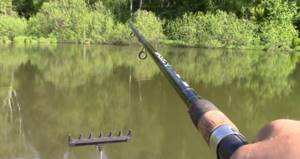
It is best to catch chub on a feeder
Fishing for chub on a float rod
When fishing from the bottom in a current, the bait is held in one place with the help of a sliding sinker. The float is immersed in water.
You can fish with a float hanging like a bell on the fishing line. Occasionally two or even three leashes are used.
The third leash can be located near the float or at half-water.
As the water gets colder or becomes cloudier after rains, the chub begins to feed from the bottom. Systematic feeding of steamed porridge or clay balls, in which chopped worms are mixed, can attach it to one place.
But still, if some other fish took it first, you can’t count on catching a large chub.
Frightened by the noise, he will leave for a long time. But small chubs, with good camouflage and silent fishing, can be caught quite often.
However, villagers in many regions of the middle zone, fishing with a float rod, sometimes manage to catch several large chubs at dawn.
For this purpose, a place with a comfortable seat on the shore is equipped. It is chosen taking into account that the angler is as little visible to the fish as possible.
Wooden fliers are installed in the water, on which two or three fishing rods are placed with floats hanging into the water.
In this case, the end of the fishing line with hook and sinker can be pulled to the shore - this will help you avoid snags.
False fishing rods are left near the water for several days to teach the chubs not to be afraid of them. In the meantime, the angler regularly takes advantage of the place.
As bait they use steamed wheat, pearl barley (preferably rolled in a meat grinder and mixed with animal feed), the above-mentioned chopped worms, May beetles or bread bugs mixed into clay, cake, as well as various bran.
If you are going to fish from above, cockchafers are tossed so that they linger in the pools and float (make sure that they are not carried away by the current).
Sometimes they make and feed two or three such places at a short distance from each other. Only after 5-7 days of painstaking work do they begin fishing.
Usually they use only one fishing rod, equipped with a strong (0.3-0.6 mm) fishing line and a large (No. 7-10) hook.
The sinker is placed or not depending on whether it is fished from above or from the bottom. Arriving at the place, the fisherman removes extra fishing rods from the flyers, leaving only one, which he baits and casts without getting up.
Now he catches it with a bait that is well known to the fish - a worm, steamed wheat or a cockchafer. The first chubs, not afraid of anything, take greedily, rushing to get ahead of each other, but gradually become more and more cautious.
In order not to scare away the rest of the fish, the fisherman tries to bring the chub to the shore as quickly as possible, sometimes even without giving it a chance to move at all.
That is why the tackle used is very durable. When bitten, the float usually immediately goes under the water without twitching.
The fisherman moves the rod forward to allow the fish to take the bait deeper and only then hooks it.
The inside of the chub’s mouth is fleshy, so if you have reliable tackle, you shouldn’t be afraid that it will get away.
When the bite in one place ends, they move to another important place, where, in order to activate the bite, they throw a pinch or two of bait into the water, which can create a slight turbidity to stimulate the fish’s appetite. Thus, in cloudy, quiet weather, you can sometimes fish all day.
Fishing with a slowly sinking bait is practiced in places where insects are close to each other.
Very often, flocks stand under bent trees, near overhanging cliffs, waiting for insects falling into the water. This is where you need to throw a tackle equipped with a small float and a sinker that can slowly sink the bait.
When fishing with sinking insect larvae, there is no sinker at all, which increases the catchability of the gear.
In this way I successfully caught small chubs in the lower reaches of the Ugra River. I used bark beetle larvae or small green caterpillars collected on the leaves of coastal nettle.
Usually, when plunging, the bait did not even have time to travel halfway, but if it reached the bottom, I immediately recast.
Under some trees it was possible to catch two or three fish in a short time. This fishing is fast, and you should change places more often.
In a similar way, only with a self-loading float, I had to fish on the Upa River.
After a short heavy rain, when strong flows of water slightly stir up the water, the chub approaches streams and gullies with drains, trying to profit from food washed away from the shore.
This passion of his must be used and bait should be thrown into such places from afar.
One of the ways of fishing with a float rod is by throwing it up. Usually the fisherman walks along a narrow river and throws bait under the bushes of the opposite bank.
It is more difficult to fish from a boat or by wading; in this case, I usually combine a cast with a line that delivers the bait to remote protected areas.
It is easier to use a small float made of cork or foam, painted in discreet colors.
At dusk, when fattening fish can mistake a tiny object for a fallen beetle or a jumping frog, a small tee attached to the base of the float would be useful.
It’s especially good to catch the fly on clear moonlit nights on the day the mayfly emerges, when any fish bites on these butterflies. The mayfly should be hooked from the head, and several at a time. In this case there is no sinker.
Sometimes you have to fish in areas of a reservoir very distant from the shore. To do this, you need to have a float tackle of a slightly different device.
A spinning rod is equipped with an inertial or non-inertial reel and a long fishing line (cross-sectional thickness 0.2-0.4 mm).
A sliding float, which has a round or olive shape, is attached to the line using two cambrics. It should be clearly visible from a distance, but not scare away the fish with unnatural tones.
To do this, it is painted green on the bottom and white on top. A leash (0.15-0.3 mm) is tied to the line, above which a heavy (30-50 g) and flat-shaped sinker is placed.
The leash ends with hook No. 4-10, depending on the size of the intended fish and the type of bait.
For example, when fishing with live bait, the hook can even be No. 11-12. At the same time, in order for live bait (preferably minnow) to remain alive for a long time, it is better to insert it through the nostril.
Usually, hooks with a long shank are selected for baits of animal origin, and hooks with a short shank for vegetable baits.
It’s a good idea to use pellets of bread crumb and young undercooked potatoes as bait. They are put on a small threesome, which is then well camouflaged.
Sometimes anise oil can be added to bread as a flavoring agent. Potatoes are taken no larger than the size of a walnut and boiled directly in the peel, sometimes they are fried in vegetable oil.
Experienced fishermen have two or three of these fishing rods and fish with different baits. A very large chub almost always approaches the bait only some time after it falls into the water.
Chub from the bottom usually bite better at night or early in the morning, but when fishing with long casting, the bite is also observed during the day, in particular during wind, rain and weather changes.
Fishing with float and wire rods using live bait deserves special attention. As autumn approaches, large chub increasingly display predatory instincts.
The live bait must have a driven body, since the chub, unlike predators, grabs it from the tail. Considering the latter, it is advisable to use two hooks on a leash.
One hook clings to the lip or back, and the other is hidden in the tail of the fry. The best live bait here is gudgeon and char, but you can also catch small roach, dace or bleak.
In summer, at night or at dawn, fattening chub are caught on fry near the surface. A hollow ball float made of transparent plastic can be indispensable here.
In Ukraine, chub (local name smut) is successfully caught from the bottom using river lamprey larvae, the extraction of which, however, is a very difficult task.
To do this, the soil raised from the bottom is crushed and washed. The larva is placed from the head or behind the back closer to the head.
But it’s not easy to pick up the larva - it slips out all the time, so for convenience, your fingers get dirty in dry sand.
In the autumn, in good weather, the chub comes out to hunt for fry in the riffles and rapids. This is where we need to track him down.
Live bait is usually cast in mid-water or near the bottom with or without a light sinker. Caught by the current, he floats ahead of the float.
It is better to choose a place where the rapids end in a drain. Sometimes it is in this place that the chub waits for the fry.
Float rods, adapted for fishing from the bottom in the current and baited with minnows, are very good to leave overnight in holes and pools.
In this case, the rod is stuck into the shore or attached to a flyer. Often large chub take live bait at night.
Source: https://supersadovod.ru/ryibalka/golavl/uzhenie-golavlya-na-poplavochnuyu-udochku/
Choosing a float for chub
When fishing for chub, it is important to consider not only the carrying capacity and shape of the float, but also its color. Brightly colored floats can simply scare away wary fish. Moreover, the shallower the fishing depth, the more invisible the float should be. When fishing on the surface, it is better to use transparent water-filled floats that simulate an air bubble. They are used without additional loading, and the length of the leash is increased to 1–1.5 meters.
An improvised replacement for a water-filling float can be a piece of a branch, not cleared of bark, 8–12 cm long and about a centimeter in diameter. Swimming horizontally, it looks natural and does not alarm the chub.
